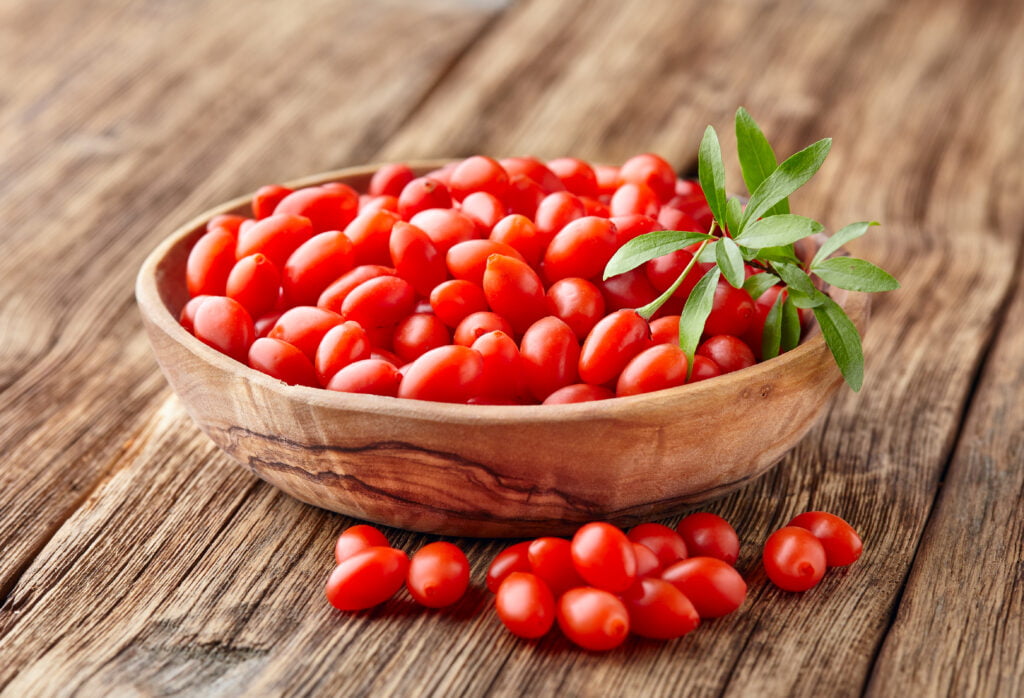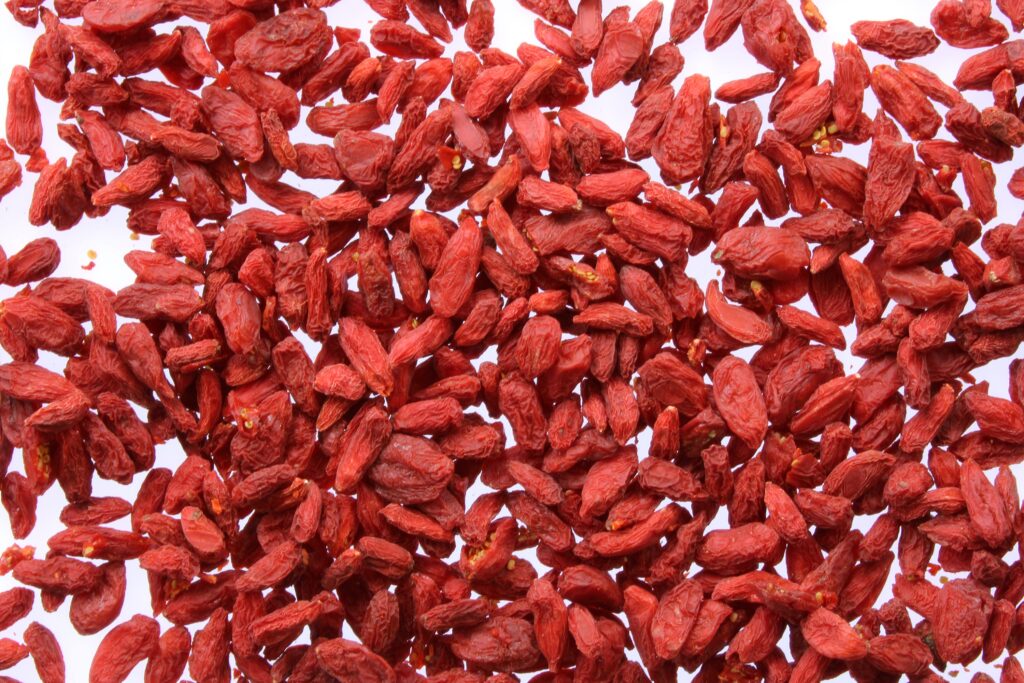The Ultimate Guide to the Nutrition and Benefits of Goji Berries

An Introduction to the Nutritious Goji Berry
Goji berries, also known as wolfberries, are a bright red superfruit native to Asia that has recently grown in popularity in the West. With a long history of use in Traditional Chinese Medicine and packed with antioxidants, vitamins, and minerals, goji berries have many potential health benefits. This introductory chapter will cover what exactly goji berries are, their other common names, and a brief history of their origins and traditional uses.

What are Goji Berries?
Goji berries come from a fruit-bearing shrub called Lycium barbarum that is native to Asia, particularly China. The shrubs produce bright red berries that resemble small cherry tomatoes. Dried goji berries are more commonly found in Western markets, with a raisin-like texture. They have a slightly sweet and sour taste, similar to a cross between a cherry and cranberry.
Goji berries have been used for centuries in Traditional Chinese Medicine and are considered a superior tonic herb. They remain a staple in Chinese cooking and herbal medicine today. However, goji berries have only been introduced to Western markets and natural health stores more recently.
Other Common Names for Goji Berries
Goji berries are known by many other names, including:
- Wolfberry
- Gou qi zi (Chinese name)
- Duke of Argyll’s tea tree
- Matrimony vine
- Barbary matrimony vine
- Himalayan goji
A Brief History and Origin of Goji Berries
While goji berries are now gaining more popularity globally, they have an extensive history of use in Traditional Chinese Medicine dating back centuries.
- Goji berries are native to Asia, particularly northern China. References to their medicinal use in ancient Chinese medical texts date back nearly 2,000 years.
- In traditional Chinese medicine, goji berries were used to help support liver and kidney health, strengthen immune function, improve eyesight, and promote longevity.
- Goji berries grow well in the Himalayan valleys and have been cultivated there for many generations. They are integrated into Tibetan medicine as well.
- Goji berries were likely introduced to the West in the late 18th to early 19th century. However, they only started gaining traction in Western natural health markets in recent decades.
With their high nutrient content and antioxidant levels, it’s no wonder goji berries have such a long history of traditional use in Chinese medicine. Keep reading to learn more about the nutritional benefits goji berries have to offer.
Chapter 2: The Nutrition and Health Benefits of Goji Berries

When it comes to nutrients and health benefits, goji berries deliver. These small red berries are packed with vitamins, minerals, fiber, antioxidants, and other beneficial plant compounds. Consuming goji berries regularly may provide protection against chronic illnesses and promote overall wellbeing.
Key Nutrients in Goji Berries
Though small, goji berries contain an impressive nutrient profile. Here are some of their standout nutrients:
| Nutrient | Amount per 28g (5 tbsp) serving | % Daily Value* |
|---|---|---|
| Calories | 98 | 5% |
| Total Fat | 0.1g | 0% |
| Saturated Fat | 0g | 0% |
| Cholesterol | 0mg | 0% |
| Sodium | 83.4mg | 4% |
| Total Carbohydrate | 21.6g | 8% |
| Dietary Fiber | 3.6g | 13% |
| Total Sugars | 12.8g | 26% |
| Protein | 4g | 8% |
| Vitamin C | 13.6mg | 15% |
| Calcium | 53.2mg | 4% |
| Iron | 1.9mg | 11% |
| Potassium | –mg | –% |
*Percent Daily Values are based on a 2000 calorie diet.
Goji berries also contain antioxidants like zeaxanthin and carotenoids. These compounds fight free radicals and oxidative stress in the body.
The Potential Health Benefits
With their stellar nutrient profile, goji berries have been connected to many potential health benefits:
- Immune support: The vitamins A and C, zinc, and antioxidants in goji berries help strengthen the immune system and ward off illness.
- Heart health: The fiber, vitamins, and plant sterols in goji berries help support healthy cholesterol levels and blood pressure.
- Anti-aging effects: The antioxidants may help fight wrinkles, cell damage, and muscle decline associated with aging.
- Eye health: Zeaxanthin and carotenoids promote eye function and defend against macular degeneration.
- Blood sugar control: Compounds in goji berries may help increase insulin sensitivity and stabilize blood sugar.
While more research is still needed, the initial evidence on goji berries is promising. Adding these superfruit berries to your diet could help boost your daily nutrient intake and promote whole-body wellness.
Creative Ways to Eat and Enjoy Goji Berries

Beyond their health benefits, goji berries have a sweet-tart taste that makes them a tasty addition to meals and snacks. Here are some simple ideas for using goji berries in your cooking and daily routine:
Eat Raw or Dried as a Healthy Snack
Goji berries are perfect for on-the-go snacking direct from the bag. Their chewy texture and burst of flavor satisfy sweet and sour cravings. Try mixing dried goji berries with nuts like almonds or cashews for some added crunch.
Add to Smoothies and Yogurt
Drop a handful of dried goji berries into your morning smoothie or overnight oats. They add nutritional value along with a punch of flavor. Goji berries also make a great topping mixed into Greek yogurt or chia pudding.
Toss into Salads, Soups, and Entrees
Fresh or rehydrated dried goji berries pair well in savory dishes too. Add them to grain bowls, chicken or fish dishes, and leafy green salads for some natural sweetness. You can also find goji berries in packaged trail mixes.
Brew Goji Berry Tea or Juice
For a soothing cup of antioxidant-rich tea, simply steep dried goji berries in hot water for 5-10 minutes. You can also blend goji berries with other fruits/veggies into a daily juice or smoothie.
Bake into Energy Bites and Bars
Blend dried goji berries into the batter for homemade granola bars, energy bites, or muffins. They add nutrients plus chewy texture.
Use in Sauces and Dressings
Puree fresh or rehydrated goji berries into a sauce for meat or sweetener for vinaigrettes. Their color and mild sweet/sour taste enhances many dishes.
With their versatility, it’s easy to find ways to eat more goji berries for their nutritional benefits. They make a simple addition to both sweet and savory recipes.
Tips for Buying and Storing Goji Berries

When adding goji berries to your diet, follow these guidelines for choosing quality berries and storing them properly.
Look for Organic, Non-GMO Berries from Reputable Sources
Whenever possible, choose certified organic goji berries to avoid pesticide exposure. Confirm the berries are non-GMO as well. Purchase goji berries from reputable health food stores or online retailers that follow strict sourcing guidelines.
Proper Storage for Maximum Freshness
To retain the most nutrients and shelf life, store goji berries properly:
- Keep dried goji berries in a sealed, airtight container in a cool, dark place. An opaque jar works well.
- Refrigerate fresh goji berries in a breathable container. Use within 1-2 weeks for best quality.
- Freeze fresh goji berries in an airtight bag for 3-6 months of storage.
Know the Difference Between Dried and Fresh Goji Berries
Dried goji berries are more common and have a longer shelf life. Fresh goji berries are more perishable but have a more intense flavor and moisture. Dried berries need to be rehydrated before eating. Both dried and fresh berries pack in nutrients.
Following these simple tips when buying and storing goji berries helps retain their signature taste, texture, and nutritional value. Proper storage keeps goji berries fresher for longer so you can add them into your recipes.
Chapter 5: Possible Precautions and Side Effects of Goji Berries
While generally safe when eaten in moderation, there are some potential side effects to be aware of with goji berries.
Goji Berries are Likely Safe for Most When Eaten as Food
For most people, eating goji berries in normal food amounts is considered safe and healthy. There are no major side effects reported when goji berries are eaten in moderation as part of a balanced diet.
However, eating too many goji berries could potentially cause minor stomach upset or diarrhea due to their fiber content. As with any food, moderation is key.
Possible Medication Interactions
Goji berries contain compounds that can impact blood clotting and blood sugar regulation. People taking certain medications should use caution:
- Blood thinners – Goji berries may intensify the effects of blood thinning medications. Consult a doctor first.
- Diabetes medications – Goji berries may further lower blood sugar. Monitor levels closely.
- Pregnancy – More research is needed on goji berries in pregnancy. Speak with your healthcare provider first.
Allergic Reactions are Possible
Some people may be allergic to goji berries. Try a small amount first to check for any reactions like itching, swelling, or throat irritation. Discontinue use if any food allergy symptoms develop.
While goji berries are likely safe for most as part of a balanced diet, it’s wise to moderate intake and consider any medication interactions or allergies first. As always, consult your healthcare provider with any concerns.
Conclusion: A Nutritious Addition to Your Diet

Goji berries are a little red superfruit that makes a great addition to a healthy, balanced diet. Here’s a recap of some of the key points:
- Goji berries are chewy, nutrient-dense berries native to Asia with a mild sweet-tart taste. They have a long history of use in Traditional Chinese Medicine.
- Packed with antioxidants, vitamins A and C, fiber, and other nutrients, goji berries provide many benefits like supporting immune health, eye health, and blood sugar regulation.
- You can eat goji berries raw, dried, or rehydrated. Add them to smoothies, oatmeal, salads, entrees, and snacks for extra nutrition and flavor.
- Look for organic, non-GMO dried, or fresh goji berries from reputable sources. Store properly in the fridge or freezer to retain maximum freshness.
- While generally safe, moderate your intake of goji berries and be cautious if taking certain medications due to possible interactions.
Incorporating nutrient-rich goji berries into your meals, snacks, juices or teas is an easy way to boost your daily nutrient intake. Their sweet taste and chewy texture make for an enjoyable health food. Try using goji berries to help support overall well-being.
FAQ
What are the potential health benefits of goji berries?
Goji berries are packed with nutrients and antioxidants, which can help boost the immune system, protect against heart disease, improve vision, promote healthy skin, and aid in weight loss.
Can I add goji berries to my diet?
Yes, adding goji berries to your diet is a great idea. You can consume them as a snack, add them to smoothies, sprinkle them on salads, or use them in recipes.
Do goji berries contain any specific nutrients?
Yes, goji berries contain essential nutrients such as vitamins A, C, and E, iron, zinc, and antioxidants like beta-carotene.
Are goji berries considered a superfood?
Yes, goji berries are often referred to as a superfood due to their high nutritional content and potential health benefits.
Can goji berries help with certain health conditions?
Research suggests that goji berries may have positive effects on conditions such as diabetes, high blood pressure, and age-related eye diseases.
Are goji berries safe for everyone to consume?
Goji berries are generally safe for most people, but it’s always best to consult with a healthcare professional if you have any existing health conditions or are taking medication, especially blood thinners like warfarin.
Are goji berries available in different forms?
Yes, goji berries are available as fresh berries, dried fruits, juice, and even in supplement form.
How can I incorporate goji berries into my diet?
You can incorporate goji berries into your diet by adding them to smoothies, yogurt, oatmeal, trail mix, or using them as a topping for desserts.
How do goji berries taste?
Goji berries have a slightly sweet and tangy taste, similar to a combination of dried cranberries and cherries.





